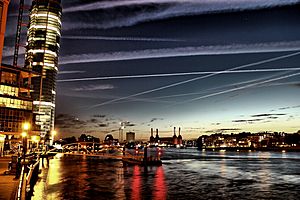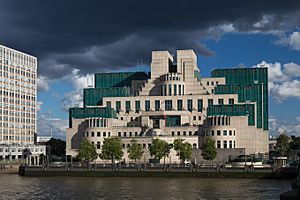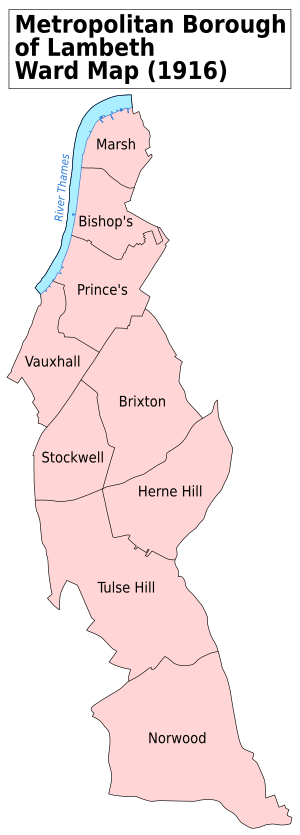Vauxhall facts for kids
Quick facts for kids Vauxhall |
|
|---|---|
 River Thames looking upstream from Vauxhall Bridge showing (left) St George Wharf Tower and (centre) Battersea Power Station, and the shorelines, left to right, of Vauxhall, Nine Elms, Battersea and Pimlico |
|
| Population | 14,262 (Princes ward, 2011) |
| OS grid reference | TQ305785 |
| • Charing Cross | 1.59 mi (2.6 km) NNE |
| London borough | |
| Ceremonial county | Greater London |
| Region | |
| Country | England |
| Sovereign state | United Kingdom |
| Post town | LONDON |
| Postcode district | SW8 |
| Dialling code | 020 |
| Police | Metropolitan |
| Fire | London |
| Ambulance | London |
| EU Parliament | London |
| UK Parliament |
|
| London Assembly |
|
Vauxhall is a lively area in Central London, located in the London Borough of Lambeth. It got its name from an old medieval estate called Fox Hall. This area became famous for its fun Vauxhall Pleasure Gardens.
For many years, from the Victorian times until the mid-20th century, Vauxhall was a mix of factories, businesses, and homes. Many of these homes were for workers. After World War II, some were replaced with new social housing by Lambeth Council. Today, many old industrial sites along the River Thames have been turned into modern homes and offices.
Vauxhall has even given its name to the Vauxhall Bridge, a local parliamentary area, and the well-known car company, Vauxhall Motors.
Contents
Exploring Vauxhall's Location
Vauxhall is about 2.1 kilometers (1.3 miles) south of Charing Cross. It sits right next to the River Thames, across from the Pimlico area. To the north is Lambeth, and to the northeast is Kennington.
Many roads in Vauxhall meet at a busy spot called Vauxhall Cross. Here, you'll find Vauxhall station, which has both train and bus services. Nearby are the Vauxhall Pleasure Gardens and the large Vauxhall Park.
Vauxhall's Past: A Look Back
What's in a Name?
The name Vauxhall likely comes from the late 13th century. It was named after Falkes de Breauté, a leader of King John's soldiers. He owned a large house in the area called Faulke's Hall. Over time, this name changed to Foxhall and then to Vauxhall.
The famous Vauxhall Pleasure Gardens opened to the public, and the area became widely known as Vauxhall. This happened especially after Westminster Bridge opened in the 1740s, making it easier to cross the Thames.
Vauxhall in Russian
It's interesting that the Russian word for a main railway station is vokzal (вокзал), which sounds like Vauxhall. One idea is that a Russian group visited London in 1840 to see the London & South Western Railway. They might have thought the station's name, "Vauxhall," was the general word for a railway building.
However, the first public railway in Russia was built in 1837. It went to Pavlovsk Palace, which had large pleasure gardens. In 1838, a music hall was built at the end of this railway line. This hall was called the Vokzal to honor the Vauxhall Pleasure Gardens in London. Soon, the name was used for the station itself. Later, it came to mean any large railway station.
The word voksal (воксал) was actually known in Russian as "amusement park" even before the 1840s. It appeared in writings as early as 1777. An Englishman named Michael Maddox even opened a Vauxhall Gardens in Russia in 1783, with gardens, a theater, and places to eat.
Early Days of Vauxhall
Vauxhall wasn't mentioned in the 1086 Domesday Book. The area was part of a larger estate called South Lambeth. In 1216, Falkes de Breauté gained control of South Lambeth. Later, in 1293, King Edward I took over the land.
In 1317, King Edward II gave the Vauxhall estate to Sir Roger d'Amory. This was a reward for his help at the Battle of Bannockburn.
Three old roads passed through Vauxhall: South Lambeth Road, Clapham Road, and Wandsworth Road. These were important routes to and from London. During the English Civil War in 1642, Londoners built defenses, and Vauxhall was at the southwestern end of these forts.
How Vauxhall Grew
The land in Vauxhall was flat and sometimes wet. It only started to be built up in the mid-1700s after the Lambeth Marsh was drained. Before that, it was used to grow food for London.
Vauxhall Bridge and Vauxhall Bridge Road opened in 1816. By 1860, Vauxhall had become part of the larger town of Lambeth. Many streets in Vauxhall were destroyed when the railway to London Waterloo was built. More damage happened during German bombing in World War II.
People and Homes in Vauxhall
In the late 1990s and early 2000s, London property prices went up a lot. This led to many new buildings along the river in Vauxhall, like the large St George Wharf development. More new buildings are still being constructed.
Vauxhall has some nicer areas with older terraced houses. However, most homes in Vauxhall (97%) are flats. Vauxhall is a popular place for Members of Parliament and government workers to live because it's close to the Houses of Parliament and Whitehall.
Vauxhall is a very diverse area. About half of its residents are from non-white ethnic groups. There's a large Portuguese community, with many Portuguese restaurants and bars along South Lambeth Road.
According to the 2021 census, most residents (39.5%) are Christians. About 9.3% of residents are Muslim.
Vauxhall's Economy
Vauxhall has many light industries, offices, and government buildings. In the past, companies chose Vauxhall because it was central but cheaper than Westminster. Recently, the riverside has been redeveloped with new homes and offices. A famous building here is the SIS Building at Vauxhall Cross. Many new businesses have also moved into the area.
Famous Places in Vauxhall

Near Vauxhall Bridge is the main building for the British Secret Intelligence Service (also known as MI6). This building, called Vauxhall Cross, was built between 1989 and 1992. South of Vauxhall Bridge, a large group of apartments and offices called St George Wharf has been built. This includes the tall St George Wharf Tower, finished in 2014.
The MI6 building has appeared in several James Bond films. It's been shown in movies like GoldenEye, The World Is Not Enough, Skyfall, and Spectre. One film, Die Another Day, even showed a fictional London Underground station called Vauxhall Cross, which was supposedly used by MI6.
Vauxhall is also home to Brunswick House. This old Georgian mansion was built in 1758. It used to be surrounded by large gardens. Today, it's overshadowed by the St George Wharf complex. The building was restored in 2004 and now sells architectural items. It also has a restaurant and hosts events.
St Peter's Church, Vauxhall in Kennington Lane was designed by the architect John Loughborough Pearson in the 1800s. He also designed Truro Cathedral in England. Today, the church building is used as a community center and arts venue, as well as a church. Next to St Peter's is Vauxhall City Farm.
Getting Around Vauxhall
Vauxhall has excellent transport links. You can find London Underground (Tube) trains, National Rail trains, and London buses all at Vauxhall station. The Tube station is on the Victoria line. Other Tube stations on the Northern line are also nearby. The train station has services by South Western Railway to London Waterloo.
Vauxhall bus station has 14 bus routes that go to different parts of London. There's also a river bus service at Vauxhall (St George Wharf) Pier. You can travel east to Greenwich or west to Putney by boat.
Vauxhall is considered one of London's best-connected transport areas. It has the highest possible rating for public transport access. Besides public transport, Vauxhall has major roads and the Thames Path for walking and cycling. There are also Santander Cycles docking stations and a main cycle route, Cycle Superhighway 7.
Vauxhall Cross Junction
Vauxhall Cross is a busy road junction right next to Vauxhall Bridge. Six major roads meet here. It was once described as a very unpleasant road junction. However, it was redesigned between 2002 and 2004.
The redesign included changes to traffic lanes, better crossings for walkers and cyclists, and a new bus station. The bus station, finished in 2004, has a cool wavy roof. This roof has special panels that create electricity from sunlight, helping to power the bus station's lights.
There are plans to redevelop Vauxhall Cross bus station into a new area with offices, hotels, and shops. This project is expected to cost a lot of money.
Nearby Tube Stations
- Vauxhall
- Nine Elms
- Kennington
- Oval
- Pimlico
- Stockwell
Fun Things to Do in Vauxhall
Vauxhall Park has a special area with miniature model houses. It also has tennis courts, a day care center, and a children's playground. The park is open every day and has an "open day" once a year.
Vauxhall City Farm, located within Vauxhall Pleasure Gardens, is open daily. You can see many animals there, including alpacas, sheep, goats, and pigs.
Vauxhall is also home to the Vauxhall Gardens Estate Residents and Tenants Association (VGERTA). This group represents 2,500 residents and has won awards for helping the local community. One of their biggest achievements was raising £165,000 to completely rebuild the Glasshouse Walk Playground in 2013.
See also
 In Spanish: Vauxhall (Londres) para niños
In Spanish: Vauxhall (Londres) para niños





